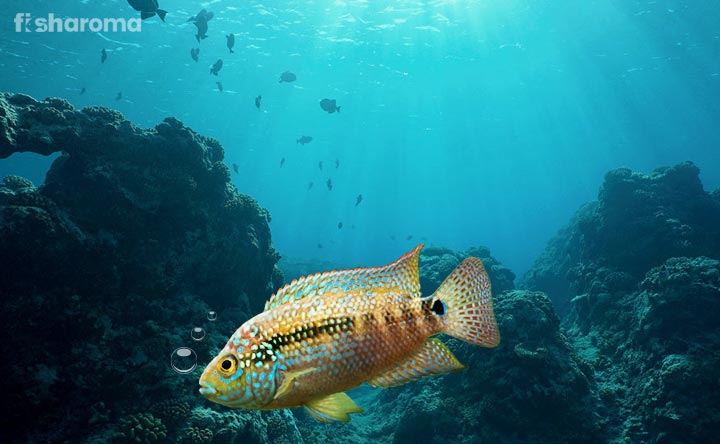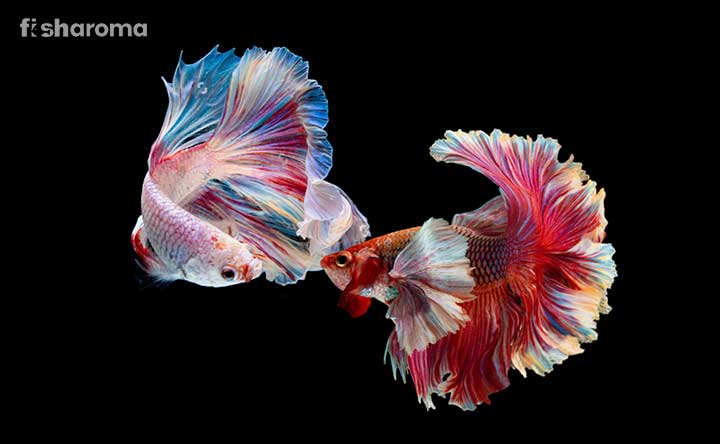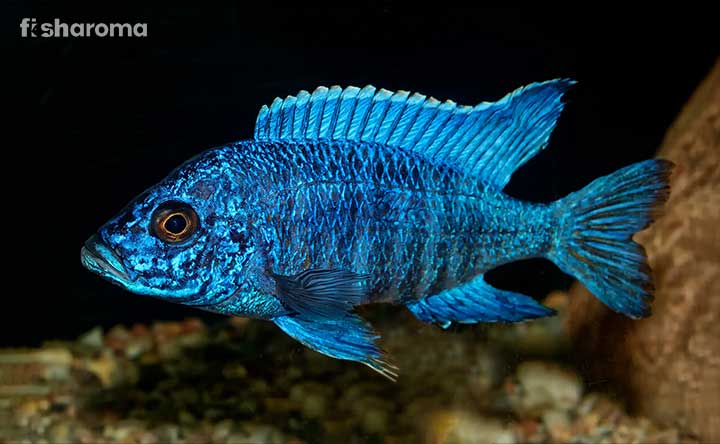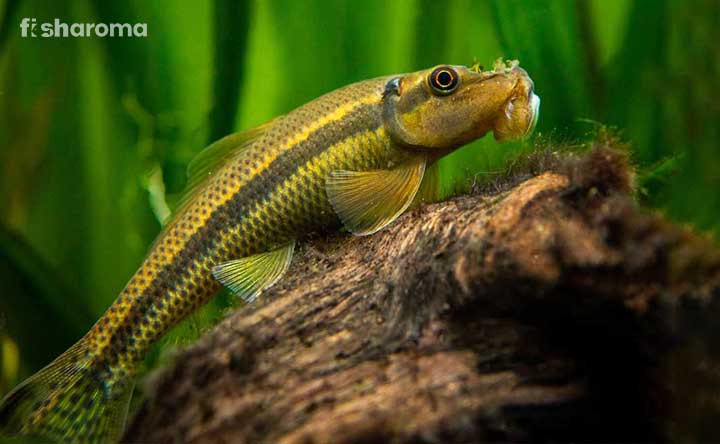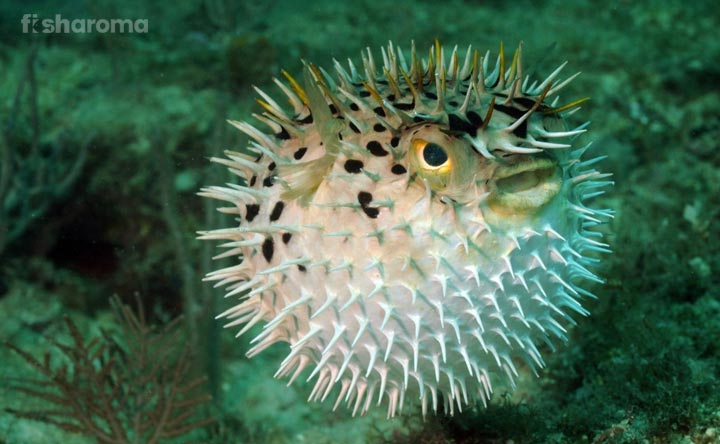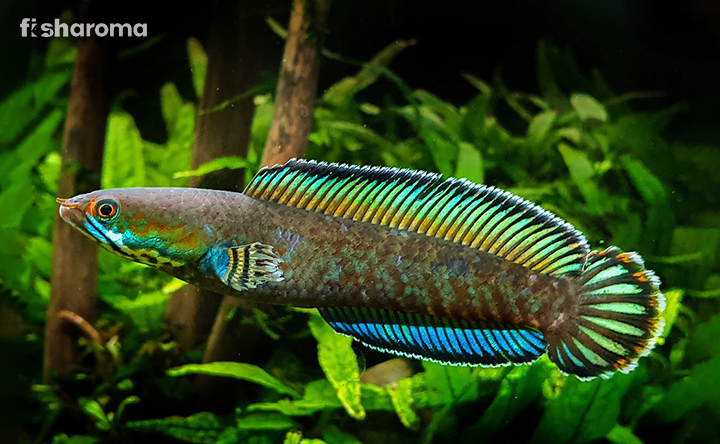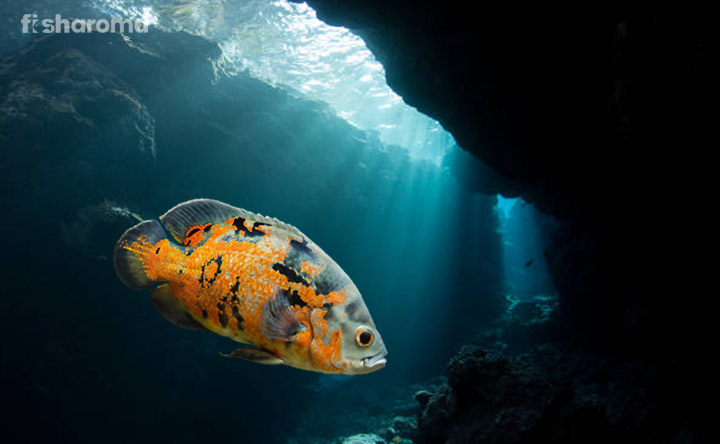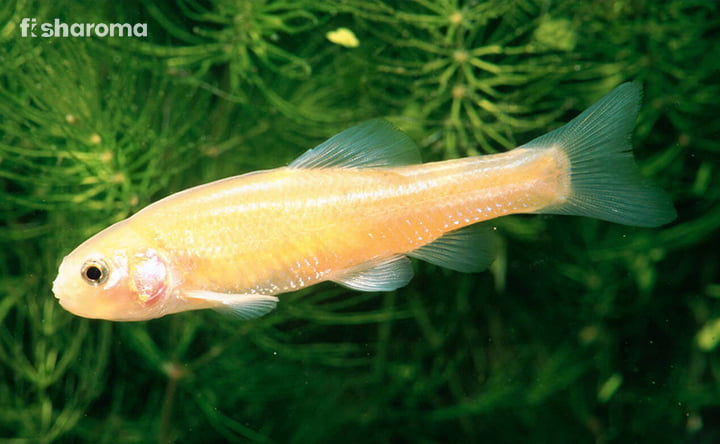Peacock Gudgeon – A Care Guide To Peacock Goby

- Origin & Habitat of Peacock Gudgeon
- Appearance of Peacock Gudgeon
- Behaviour of Peacock Gudgeon
- Lifespan of Peacock Gudgeon
- Diet of Peacock Gudgeon
- Tank Requirements for Peacock Gudgeon
- Water Type for Peacock Gudgeon
- Compatibility of Peacock Gudgeon
- Breeding of Peacock Gudgeon
- Diseases of Peacock Gudgeon
- Summary
Peacock Gudgeon, also known by the name “Peacock Goby” is a beautiful breed of the tropical freshwaters. They are from the Eleotridae family in the order Gobiiformes and genus Tateurndina. As these are extremely colourful, they look absolutely stunning in an aquarium environment. So if you’re planning to make them your brand new aquarium addition, you’re in the right place. In our perfectly detailed care guide, you will get every piece of information you’re looking for. Follow through, to know it all!
Key Specifications
Some quick intel on these vibrant fishes:
| Scientific Name | Tateurndina ocellicauda |
| Origin | New Guinea |
| Lifespan | 4-5 years |
| Colours/Patterns | Red, black, white, yellow, blue, silver colours and patterns like dots, stripes. |
| Temperament | Peaceful, occasionally aggressive. |
| Size | 1-3 inches |
| Diet | Omnivorous |
| Family | Eleotridae |
| Compatibility | Peaceful community of fish. |
| Tank size | 15 gallons |
| Care level | Easy |
| Water preference | Freshwater |
| Breeding | Egg-layers |
Overview
The Peacock Gudgeon (Tateurndina ocellicauda) are tropical fishes of immense beauty. They have an easy care routine along with their great community compatibility. Having a decent lifespan of about 5 years makes this fish worth every penny, as even feeding them has a lot of options, as a result of their omnivorous preference. Clearly, they have more on the plate other than just their beautiful coloration and contrasts!
Origin and Habitat of Peacock Gudgeon
These fishes are based off of Papua, New Guinea. Other than that, Peacock Gudgeons are found all over Australia and New Zealand.
When it comes to their habitat preference, they prefer shallow water bodies like slow-paced streams and still ponds. The waters need to have a dense layer of vegetation, preferably with temperature on the warmer side.
Appearance of Peacock Gudgeon
Talks of their vibrancy is everywhere in the world of aquarists. These Peacock Goby fishes are admired for their beauty. There is an absolute harmony of colours on them, standing out sharply in nature or your tank’s in-built aquascape. These Gudgeons are a great choice for most tank’s ecosystem.
With slender, long and extended bodies, the Peacock Gudgeons have a round head shape. The males have a nuchal lump on the forehead, which makes the distinguishing process slightly easier. Hence, they are sexually dimorphic as the head region of the male variants are slightly more round and pronounced than that of females.
Colour
To further have a look at their beautiful colours, contrasts and hues, let’s get started with the base colouration. There is a typical silvery shade with hints of blue, however the intensity of colours depend. Some fishes rock the electric blue base vibe, and some fishes have a more faded version of the same.
Moving to the belly part, there’s a faded yellow colouration over there. On top of this absolutely gorgeous base, they have unique laterally angled dotted red stripes. You will see them run vertically all throughout the Gudgeon’s body, length precisely.
As we shift our focus towards the fins, you will see the same base colouration of silvery-blue hues. But this time it’s combo’d with strokes of red and orangish colours. Don’t forget to notice some more poppy, bright yellow all over in selective places, like the fins. The tail fin, however, has a large eye-like spot which is mostly black. The entire peacock aesthetic roots from that single feature, hence giving the name Peacock Gudgeon.
Interesting fact: Female Peacock Gudgeons usually have thin black stripes on the yellow fin portion. This makes detection further easier, other than the head shape difference between the two sexes.
Size
The Peacock Gudgeon fishes grow about 1-3 inches, precisely around 2 inches at times. However, females barely grow past 2.5 inches. It takes about 8 months for juveniles to be mature and they don’t reach their max size at this point. In the coming few months, even after maturity they reach their expected size.
Behaviour of Peacock Gudgeon
The Peacock Gudgeons are mostly peaceful, with love for large groups of 6-8. It is fine to keep them in single pairing, but they majorly prefer the group option. These fishes pose no threat to similar temperament species of close-by size range.
However, you will often see some aggression amongst the male variants, while swimming about in a group situation. The sparring is mostly light-hearted with no injury involved usually. You’ll often see them swimming with grace and joy throughout the open spaces in your tank, showing off their beauty for everyone’s eyes to see.
Lifespan of Peacock Gudgeon
Their lifespan is around 4-5 years, provided you give them good care, properly feed and see to their ailments as soon as possible. Just passionately work after their keep, to see them thrive in your aquarium.
Diet of Peacock Gudgeon
These Peacock Gudgeons may be omnivorous, but they do have the picky glasses on, when it comes to what exactly they wish to consume. Just make sure the food you’re feeding them is rich in proteins.
They naturally prey on:
- Larvae
- Insects
- Smaller critters
Here goes a healthy menu for our precious Bettas:
- Frozen fish snacks
- Live fish snacks
Important segregated choices:
- Brine Shrimp
- Mosquito Larvae
- Bloodworms
- Daphnia
Tank Requirements for Peacock Gudgeon
Tank requirements are really important when it comes to the health of our precious Peacock Gudgeon . Let’s have a quick look at the what we need:
Tank Lid
Although, they are not prolific or anything when it comes to jumping but they have somewhat jumping tendencies. It’s likely that they might jump out, so it’s best to provide them with a hood or tank lid to stop any kind of unexpected accident. Additionally, the tank lid prevents the water from pollution by stopping dust or any other harmful elements from getting mixed.
Tank Size
They need a classic tank size of 15 gallons, however, they can do with a bottom-line of 10 gallons just in case. It’s best to follow the recommended size, to keep your fish healthy and happy.
Substrate
A dark sand substrate works best for these Gudgeon fishes, just make sure you provide enough vegetation.
Filter
There are no specific filter requirements, as long as they are strong enough to keep the ecosystem clean and well oxygenated.
Ornaments
You can be really free with decorations like hanging bridges and caves. Just remember to leave enough swimming space, as these fishes love to flutter about in groups throughout your aquarium.
Lighting
Subdued, dim lighting works the best for Peacock Gudgeons.
Presence of Flora
They love the presence of vegetation in their tank. Even when you’re preparing the layer substrate, they appreciate plants. Let’s have a closer look at what vegetation choices we can provide for our precious Peacock Gudgeon tank:
Cleaning Method
An appropriate cleaning method is really important when it comes to the safety and maintenance of the tank. It is very likely that you will face danger dealing with your tank, if you don’t follow the proper processes to keep the tank healthy. Monitor the parameters, and other conditions with care and replace the aquarium water regularly (30% at least) or with proper intervals of time.
Other than all these important points, don’t forget to clean the tank sides, with a cotton cloth preferably. We recommend you to use proper filters and keep the tank suitably aerated.
Water Type for Peacock Gudgeon
The water profile should be perfect at all times. A lot of health-related factors depend on it, like the health and longevity in life of the fish, along with the overall tank’s ecosystem.
Let’s have a look at the parameters:
| Hardness | 5-12 dKH |
| Temperature | 22-26 Degrees Celsius |
| pH | 6.5-8 |
Hardness
They prefer soft waters, so try to keep the general hardness range around 5-12 dKH.
Temperature
The water temperature preference is on the warmer side, so maintain a temperature range of 22-26 Degrees Celsius.
pH
The Peacock Gudgeons like a little acidity in their water, so a pH range of 6.5-8 is ideal.
Compatibility of Peacock Gudgeon
As we already know, Peacock Gudgeons are compatible with most peaceful fish species of similar size. Let’s have a distinct look at who to and who not to pair them up with.
Suitable Tank mates
Some suitable tank mates:
- Kuhli Loach
- Ember Tetra
- Harlequin Rasbora
- Cory Catfish
- Guppy
- Bumblebee Goby
- Celestial Pearl Danio
- Apistogramma
- Ghost Shrimp
Unsuitable Tank mates
Never pair these beauties up with fishes bigger in size, as they might end up preying on your Peacock Gudgeon. Most aggressive fishes, like the territorial ones, love their space. A bigger tank prevents accidental invasions, as that makes the territorial fishes prone to attack and ultimately attacking your precious Gudgeon fishes. No major aggressor is a good tank mate choice for these fishes.
- Tiger Barb
- Dwarf Pea Puffer
- Axolotl
- Gouramis like Pearl Gourami
- Cichlids like Dovii Cichlid
- Shrimps like Cherry Shrimp
Breeding of Peacock Gudgeon
You’re in luck, as it’s not very complicated to breed these pulchritudinous beings. So let’s quickly run you through the entire process:
Introducing the Breedable Pair
First comes detection, so if you’re keeping your fishes in an extended group, you have to look out for potentials. Identify and create a pair, before you ultimately shift them to the breeding tank. A breeding tank is the safest way to breed your fishes.
Preparations
Keep foods very rich in protein content at hand or try healthy live fish food. Then perform a water change and keep the breeding tank ideal. Make sure the water is warm, with proper filtration and heating arrangements. Proper hiding space is a must, so something like an artificial cave surely works.
Gently introduce the breedable pair in it, allow them to adjust to the parameters and everything. Don’t forget to keep feeding them on intervals, as taking good care is only in the process’s best interest.
On-set of the Breeding Process
So, in the case of Peacock Gudgeons, the female accepts or rejects the male. The males do a little dance and flash their beautiful pectoral fins to get the female’s attention, when they are ready to breed.
On acceptance, the female takes shelter in the cave or the preferred hiding space you’ve provided. They lay about 50-100 eggs and the sticky eggs latch to the sides of the hiding spot.
The mother leaves, after which the male fish takes over. They fertilize the eggs and care for them till they are ready to hatch. They become a little territorial while protecting the eggs and sometimes even fan them in the process.
Hatching
In about 8-10 days of the entire process, the eggs begin to hatch. The male or father fish may or may not stick around. The small fry can mostly live on their own, sometimes the male sticks around just for some extra nourishment. The growth of these baby fry is not the fastest, so keep feeding them nutrient-rich feedable foods like infusoria or baby brine shrimp. They provide nutrition quickly and they are bite-sized enough for the precious Peacock Gudgeon fry.
It takes more than a couple of weeks for them to swim about freely and be prepared for the main community tank, so we recommend you to monitor them well, take proper care and keep supplying an adequate amount of food.
Diseases of Peacock Gudgeon
The Peacock Gudgeon es are exquisite beings which are beautiful and hardy. That does not mean they can’t get affected by the fatal diseases out there for most freshwater fishes.
A few diseases that mostly affects them besides the wide range of freshwater diseases:
- Ich- It is a parasitic infection caused by an ectoparasite Ichthyophthirius multifiliis, causing white spots on the skin of your Peacock Gudgeon, giving itself a name of “White Spot Disease”.
- Marine Velvet- A disease affecting the Gudgeons, is caused by the parasite Oödinium, which is a dinoflagellate. It is also known as the Gold Dust Illness.
- Anchor worms– Lernaea spp. is a copepod parasite that embeds itself into the Gudgeon’s skin and the tail pops out from the skin’s layer.
- Skin & Gill Flukes- The body gets covered in mucus and the fishes who are affected by skin flukes have clamped fins. On the other hand, gill flukes cause difficulty in breathing.
- Hole-in-the-head- HLLE, LLD, LLE is a very common aquatic and marine disease. It can fatally affect your Peacock Gudgeon as it can damage the skin around the head region.
Treatment
Some ways of treatment and prevention are as below:
- Keep a treatment tank where the sick fishes could be separated with safety.
- Monitor the tank with attention for early illness detection.
- Be sure to look out for parameter instabilities, in order to keep their health in check.
- Make sure the medication you choose for your Female Betta is appropriate. See an expert if it is hard for you to tell.
Summary
Peacock Gudgeons are magnificent fishes with eye-catching vibrancy. These simple peaceful beings are so interesting to observe in the aquarium. Especially around the time of breeding, when the male does a little act to fetch the female variant’s attention. All in all, they are a perfect addition to your aquarium both in terms of look and keeping. They are easy to keep and can very well exist in your pre-made fish community. So, what are you waiting for, get a little group of them now.
Similar Care Guides You May Like
- Odessa Barb Care Guide: This small fish is based off of Central Myanmar, with a pop of colours and small size. To know more, check right here!
- Ember Tetra Care Guide: The simplified solid colour contrast never fails to fetch your attention. Want to know more? Click here.
- Kribensis Cichlid Care Guide: This multi-coloured beauty requires a 50-gallon tank and it’s just about 4 inches. Want to know more interesting things about them? Check this out.

